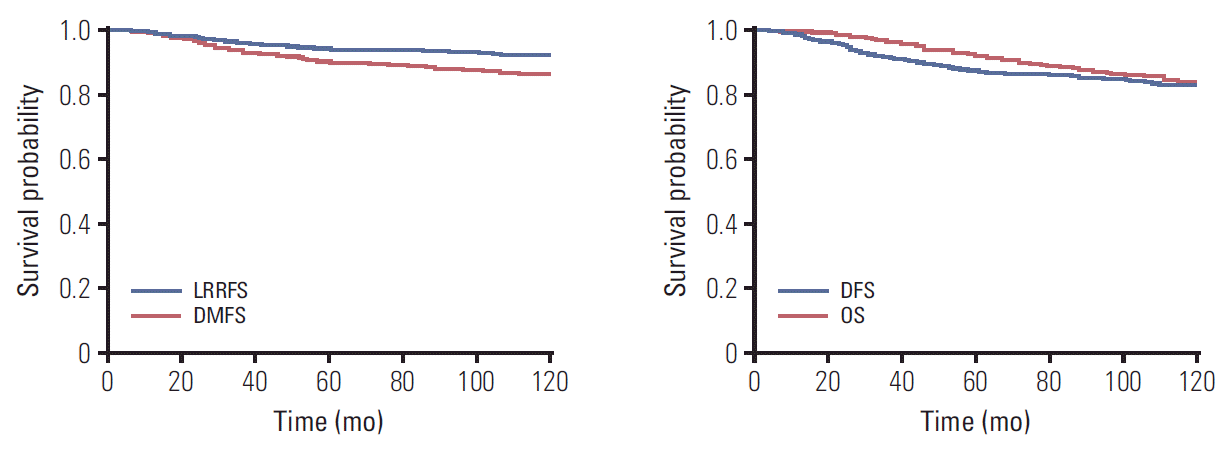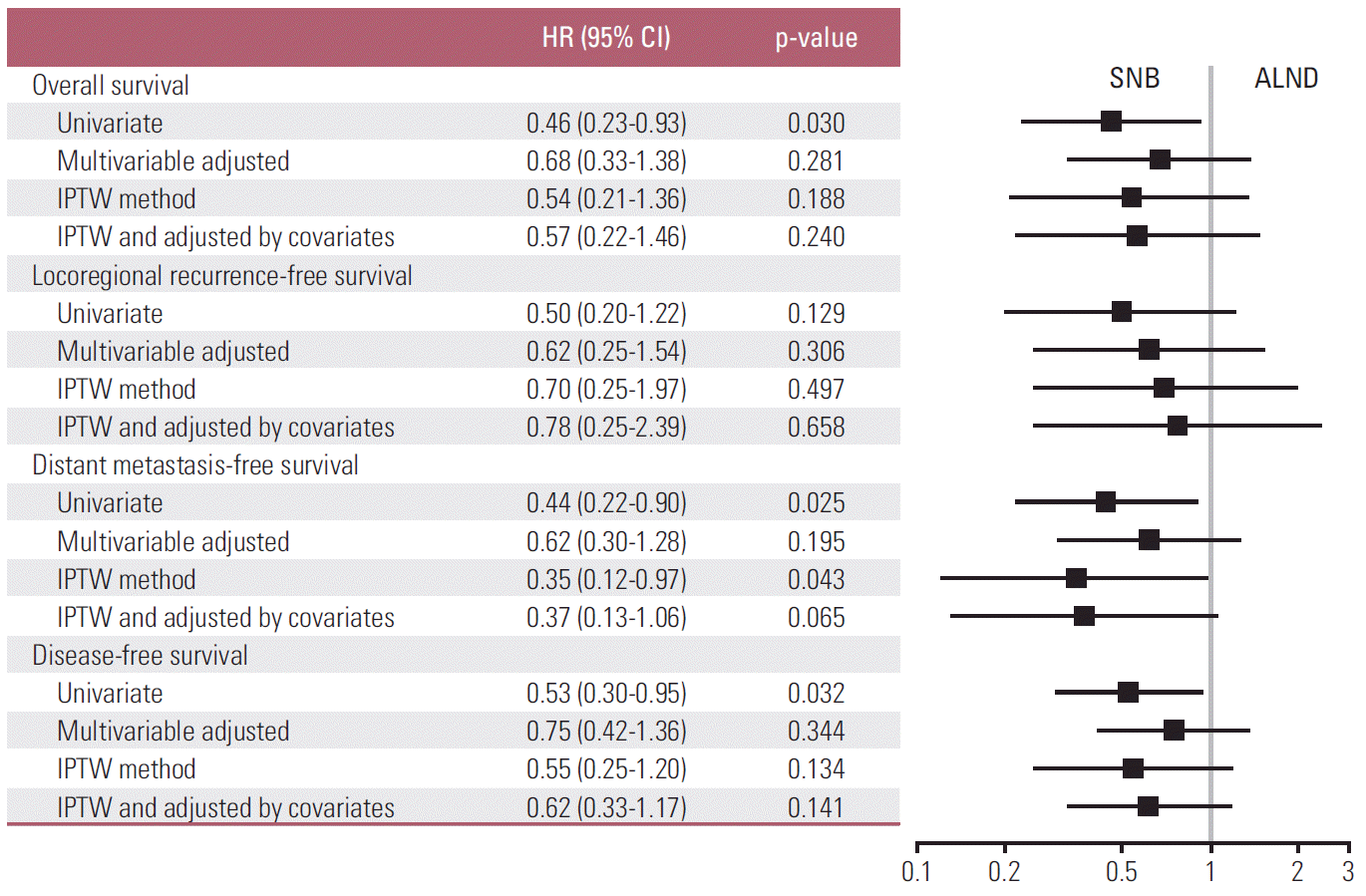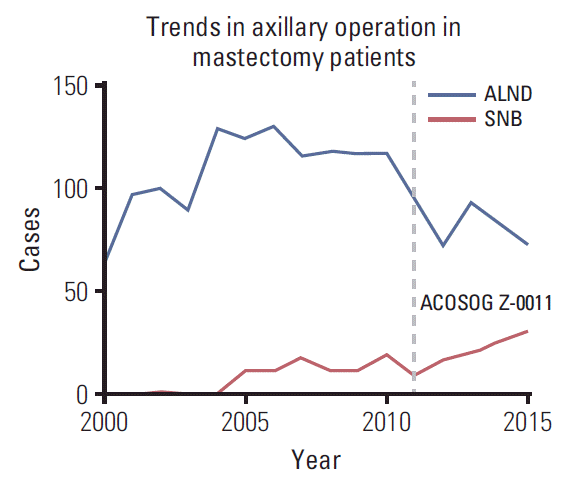Introduction
Materials and Methods
1. Patients
2. Treatment
3. Statistics
Table 1.
| Variable | Total (n=1,697) | ALND (n=1,539) | SNB (n=158) | p-value |
SDM |
|
|---|---|---|---|---|---|---|
| Before weighting | After weighting | |||||
| Age (yr) | 47.70 | 47.59 | 48.77 | 0.153 | 0.120 | 0.092 |
| BMI (kg/m2) | 23.42 | 23.44 | 23.18 | 0.395 | 0.075 | 0.105 |
| Histology | ||||||
| IDC | 1,628 (95.9) | 1,477 (96.0) | 151 (95.57) | 0.808 | 0.020 | 0.067 |
| ILC | 69 (4.1) | 62 (4.0) | 7 (4.43) | |||
| No. of tumors | ||||||
| 1 | 1,367 (80.6) | 1,237 (80.4) | 130 (82.3) | 0.502 | 0.108 | 0.171 |
| 2 | 243 (14.3) | 220 (14.3) | 23 (14.6) | |||
| ≥ 3 | 87 (5.1) | 82 (5.3) | 5 (3.2) | |||
| Locationa) | ||||||
| UOQ/LOQ | 951 (56.5) | 861 (56.5) | 90 (57.0) | 0.559 | 0.105 | 0.107 |
| Central | 394 (23.4) | 356 (23.3) | 38 (24.1) | |||
| UIQ/LIQ | 322 (19.1) | 295 (19.3) | 27 (17.1) | |||
| Whole | 16 (1.0) | 13 (0.9) | 3 (1.9) | |||
| Histologic gradeb) | ||||||
| G1 | 61 (3.8) | 55 (3.8) | 6 (3.9) | 0.021 | 0.242 | 0.132 |
| G2 | 928 (57.6) | 823 (56.5) | 105 (67.7) | |||
| G3 | 622 (38.6) | 578 (39.7) | 44 (28.4) | |||
| Tumor size (mm) | 28.26 | 28.73 | 23.70 | 0.002 | 0.283 | 0.055 |
| T category | ||||||
| T1/2 | 1,561 (92.0) | 1,413 (91.8) | 148 (93.7) | 0.413 | 0.072 | 0.064 |
| T3/4 | 136 (8.0) | 126 (8.2) | 10 (6.3) | |||
| Positive LN | ||||||
| 1 | 887 (52.3) | 758 (49.3) | 129 (81.7) | < 0.001 | 0.772 | 0.175 |
| 2 | 513 (30.2) | 488 (31.7) | 25 (15.8) | |||
| 3 | 297 (17.5) | 293 (19.0) | 4 (2.5) | |||
| Hormone receptorsc) | ||||||
| Positive | 1,201 (71.0) | 1,079 (70.3) | 122 (78.2) | 0.038 | 0.182 | 0.039 |
| Negative | 490 (29.0) | 456 (29.7) | 34 (21.8) | |||
| c-Erb B2d) | ||||||
| Negative | 995 (59.3) | 900 (59.1) | 95 (60.9) | 0.002 | 0.369 | 0.116 |
| Equivocal | 162 (9.7) | 159 (10.5) | 3 (1.9) | |||
| Positive | 521 (31.1) | 463 (30.4) | 58 (37.2) | |||
| Luminal typee) | ||||||
| Luminal | 1,201 (71.2) | 1,079 (70.5) | 122 (78.2) | 0.042 | ||
| Non-luminal | 486 (28.8) | 452 (29.5) | 34 (21.8) | |||
| p53f) | ||||||
| 0/1+/2+ | 1,249 (80.1) | 1,131 (80.0) | 118 (80.8) | 0.810 | 0.021 | 0.001 |
| 3+ | 311 (19.9) | 283 (20.0) | 28 (19.2) | |||
Values are presented as mean or number (%). ALND, axillary lymph node dissection; SNB, sentinel node biopsy; SDM, standardized difference of means; BMI, body-mass index; IDC, invasive ductal carcinoma; ILC, invasive lobular carcinoma; UOQ, upper outer quadrant; LOQ, lower outer quadrant; UIQ, upper inner quadrant; LIQ, lower inner quadrant; LN, lymph node.
4. Ethical statement
Results
1. Patient and tumor characteristics
2. Patterns of the first failure
Table 2.
3. Prognostic factors for survival
Fig. 2.

Table 3.
LRRFS, locoregional recurrence-free survival; DMFS, distant metastasis-free survival; HR, hazard ratio; BMI, body mass index; UOQ, upper outer quadrant; LOQ, lower outer quadrant; UIQ, upper inner quadrant; LIQ, lower inner quadrant; LN, lymph node; ILC, invasive lobular carcinoma; IDC, invasive ductal carcinoma.
Table 4.
4. Inverse probability of treatment weighted
Fig. 3.

Table 5.
| Outcome | HRa) | 95% CI | p-value |
|---|---|---|---|
| Overall survival (event=237/1,697) | |||
| Univariate | 0.457 | 0.225-0.926 | 0.030 |
| Multivariable adjusted | 0.675 | 0.330-1.380 | 0.281 |
| IPTW methodb) | 0.537 | 0.212-1.356 | 0.188 |
| IPTW and adjusted by covariatesc) | 0.566 | 0.219-1.464 | 0.240 |
| Locoregional recurrence-free survival | |||
| Univariate | 0.499 | 0.203-1.224 | 0.129 |
| Multivariable adjusted | 0.624 | 0.254-1.537 | 0.306 |
| IPTW methodb) | 0.698 | 0.248-1.967 | 0.497 |
| IPTW and adjusted by covariatesc) | 0.775 | 0.251-2.394 | 0.658 |
| Distant metastasis-free survival | |||
| Univariate | 0.444 | 0.219-0.901 | 0.025 |
| Multivariable adjusted | 0.622 | 0.304-1.275 | 0.195 |
| IPTW methodb) | 0.346 | 0.124-0.965 | 0.043 |
| IPTW and adjusted by covariatesc) | 0.374 | 0.131-1.063 | 0.065 |
| Disease-free survival | |||
| Univariate | 0.530 | 0.297-0.947 | 0.032 |
| Multivariable adjusted | 0.752 | 0.417-1.357 | 0.344 |
| IPTW methodb) | 0.552 | 0.254-1.200 | 0.134 |
| IPTW and adjusted by covariatesc) | 0.619 | 0.327-1.172 | 0.141 |




 PDF
PDF Citation
Citation Print
Print




 XML Download
XML Download